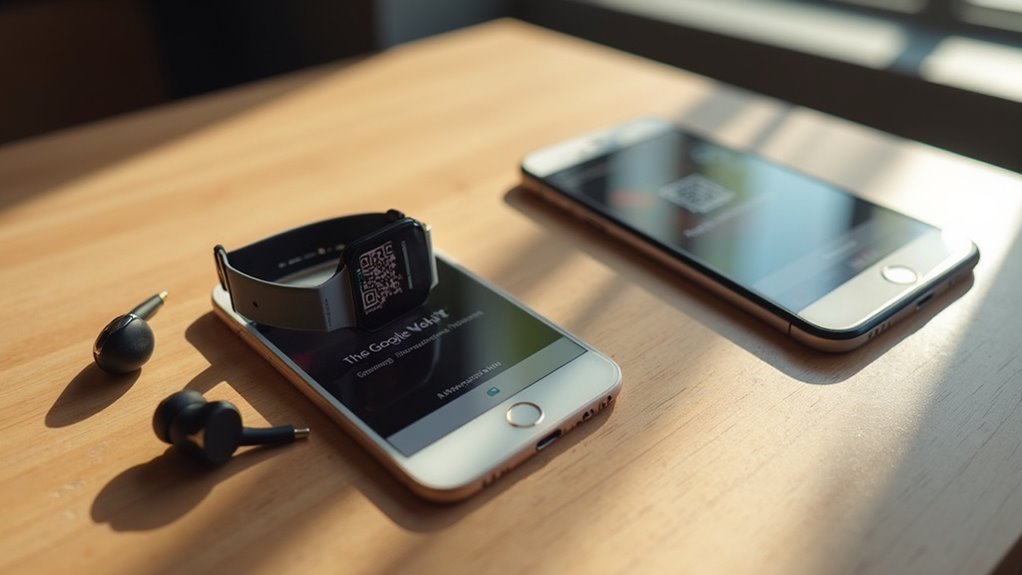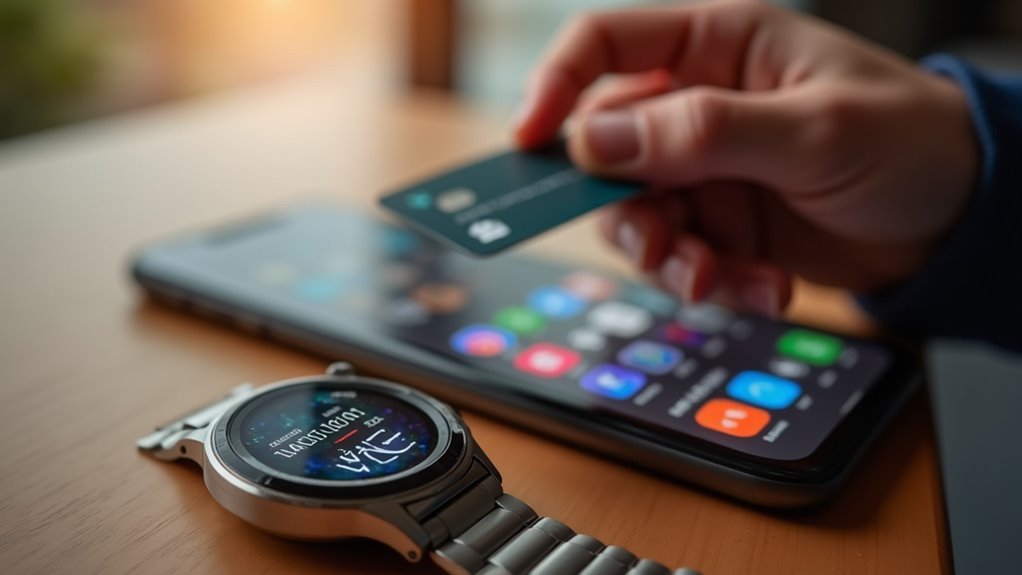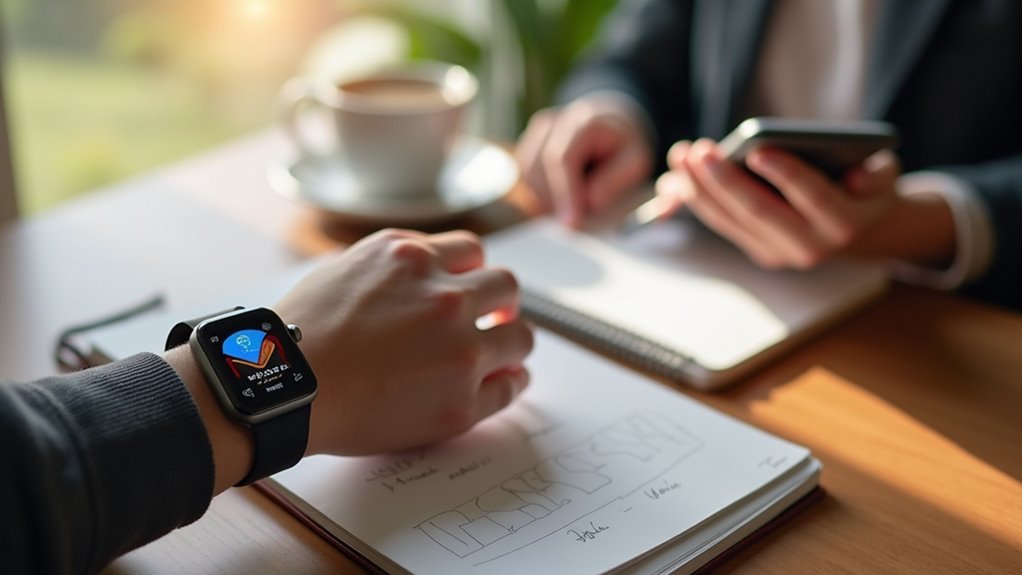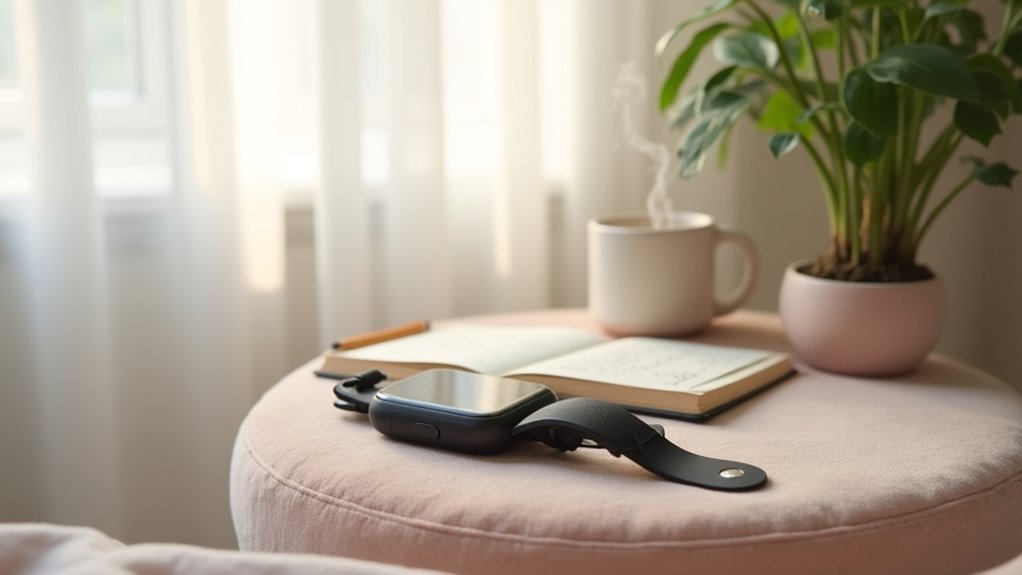To set up smartwatch payment apps, you’ll first need an NFC-enabled smartwatch and compatible payment app like Google Wallet or Samsung Pay. Download the app from your device’s store, then add payment cards by selecting “Add to Watch” on your smartphone and completing bank verification. Configure security features including PIN setup, biometric authentication, and wrist detection for automatic locking. This guide covers everything from initial setup to troubleshooting common issues you might encounter.
Understanding Smartwatch Payment Technology and NFC Requirements

When you tap your smartwatch against a payment terminal, NFC (Near Field Communication) technology enables the contactless transaction through short-range wireless communication within two inches.
Your smartwatch’s embedded NFC chip operates at 13.56 MHz radio frequency, transmitting encrypted payment credentials to compatible point-of-sale terminals.
You’ll need a smartwatch with built-in NFC capability and payment apps that comply with NFC protocols. The terminal must also support contactless payments.
Essential requirements include NFC-enabled smartwatch, compatible payment apps, and contactless-capable terminals for seamless transactions.
Your payment data gets tokenized and encrypted during transmission, creating one-time-use tokens that protect your sensitive information from fraud.
Before making payments, you’ll authenticate using biometric verification like fingerprint scanning or passcodes.
This multifactor authentication guarantees only you can access your payment credentials, making smartwatch payments more secure than traditional card transactions. The payment process completes within seconds after holding your smartwatch near the reader, automatically deducting the purchase amount from your linked account.
Compatible Devices and Platform Requirements for Payment Apps
Before you can start tapping to pay, you’ll need to verify your smartwatch supports payment apps and meets specific platform requirements.
Most Wear OS devices support Google Pay and can pair with both Android and iOS phones, though app-to-app verification doesn’t work on iOS.
Apple Watch Series models support Apple Pay seamlessly, while Samsung Galaxy watches work with Google Pay through NFC.
Your device must have NFC and HCE support for contactless payments.
Android phones need to run Android 9.0 or higher for Google Pay compatibility.
The smartwatch requires proper network connectivity and must meet specific security standards. For contactless payments to work, your phone must be nearby even though no LTE cellular plan is required.
Payment availability depends on your geographical location, as Google Pay isn’t supported everywhere.
Check your region’s specific restrictions regarding supported cards and devices before setup.
Setting Up Google Wallet on Wear OS Smartwatches

Setting up Google Wallet on your Wear OS smartwatch requires downloading the app directly from the Google Play Store on your watch and ensuring your paired smartphone has the latest version installed.
You’ll need to grant necessary permissions and notifications when opening the app for the first time.
To add payment cards, follow these steps:
- Tap the add new card icon in the Google Wallet app on your smartwatch, then select “Add to Watch” on your connected smartphone.
- Choose an existing card or enter new payment details, verifying the information and accepting Google Wallet’s Terms and Conditions.
- Complete bank verification by entering the confirmation code or authenticating through your bank’s app when prompted.
For contactless payments, bring your watch near the payment terminal and ensure the Google Wallet app is open on smartwatch to complete the transaction.
Configuring Samsung Wallet and Samsung Pay on Galaxy Watches
Setting up Samsung Wallet or Samsung Pay on your Galaxy Watch requires the Galaxy Wearable app on your paired smartphone and a Samsung account for authorization.
You’ll need to navigate to the payment settings within the app, which varies by watch model, then follow the setup wizard to link your account and enable the payment service. During setup, you’ll be prompted to create a PIN on the watch for Samsung Wallet to secure your payment transactions.
Once you’ve completed the initial configuration, you can customize security options and add your payment cards to start making contactless transactions.
Initial Setup Process
When you’re ready to configure Samsung Wallet and Samsung Pay on your Galaxy Watch, you’ll need to start with the Galaxy Wearable app on your connected phone. This app serves as your central hub for managing all watch settings and payment features.
Before diving into the setup process, confirm you’ve completed these essential prerequisites:
- Install and connect the Galaxy Wearable app to your watch, allowing all necessary permissions for proper functionality.
- Set up your Samsung account if you haven’t already, as this may be required for wallet configuration.
- Download the latest plugin updates during setup to guarantee peak performance and security features.
Once these foundation steps are complete, you’ll be ready to access your watch settings and begin configuring your payment options. Some Galaxy Watch models require activation through the Galaxy Wearable app before Samsung Pay becomes fully functional on your device.
Security Configuration Options
How secure is your smartwatch when it comes to handling sensitive payment information?
Samsung Wallet employs multiple layers of protection to safeguard your data. You’ll need to configure a device lock using either a pattern or four-digit PIN – the “None” option isn’t recommended for payment security. Your payment cards are stored using encrypted tokens, not actual card numbers, and you’ll authenticate every transaction using fingerprint, iris scan, or a separate Wallet PIN.
Enable wrist detection so your watch automatically locks when removed.
Set up SmartThings Find to remotely lock or erase wallet data if your device is lost. Remember to use strong, unique lock codes and avoid public Wi-Fi during setup. If you forget your PIN or pattern, there’s no way to reset the lock type without performing a factory reset that will erase all data on your watch.
These security features work together to protect your financial information.
Adding and Verifying Payment Cards to Your Smartwatch

Once you’ve selected your preferred payment app, you’ll need to add your payment cards to your smartwatch before making any transactions.
The process requires both your smartwatch and connected smartphone to be ready for setup.
Here’s how to add and verify your cards:
- Input Card Details: Open your payment app and enter your credit or debit card information directly into the smartwatch app.
- Complete Bank Verification: Your bank will verify the card through a temporary charge or verification code that you’ll need to confirm.
- Set Up Security Features: Configure your PIN for transactions and guarantee your smartwatch has a screen lock enabled for enhanced security.
Once verified, your card will appear in the app, ready for contactless payments at compatible terminals. The entire setup process typically takes just a few minutes to complete from start to finish.
Security Features and Authentication Setup for Safe Transactions
After adding your payment cards, protecting your smartwatch transactions becomes your next priority.
You’ll need to configure multiple security layers to safeguard your payments. Start by enabling two-factor authentication during initial setup, which requires verification from your smartphone for added protection.
Set up device-level security with a strong PIN, pattern, or biometric lock to prevent unauthorized access to payment apps.
Enable “Lock on Removal” so your watch automatically disables payments when taken off your wrist. Configure auto-lock settings that trigger when you move too far from your paired phone.
Install only official payment apps from authorized stores and keep your smartwatch OS updated. Consider biometric authentication options like fingerprint or heart rate verification, as these advanced security methods are gaining significant traction for secure wearable transactions.
These security features work together with tokenization technology to guarantee your actual card data stays protected during every transaction.
Making Your First Contactless Payment With Your Smartwatch
With your security features configured and payment cards added, you’re ready to make your first contactless payment. The process is straightforward and doesn’t require your phone to be nearby once everything’s set up.
Once configured with security and cards, contactless payments become effortless and work independently without requiring your phone nearby.
Here’s how to complete your transaction:
- Open your payment app – Launch Google Pay or Samsung Pay directly on your smartwatch to initiate the payment process.
- Position your watch near the terminal – Hold your smartwatch close to the contactless payment terminal and select “Credit” as the payment type if prompted.
- Complete the transaction – Enter your PIN if required by your financial institution, then wait for confirmation through a beep, vibration, or checkmark display indicating successful payment. Keep the watch in place for a few seconds to avoid aborted transactions.
Troubleshooting Common Setup Issues and Maintenance Tips
Even after following setup instructions carefully, you’ll likely encounter some common errors when configuring payment apps on your smartwatch.
These issues range from Bluetooth connectivity problems to app compatibility conflicts that can prevent successful installation. Sometimes payment apps may fail to function due to problems with the underlying plug-in software.
To keep your payment apps running smoothly long-term, you’ll need to establish regular maintenance habits that address these potential problems before they disrupt your transactions.
Common Setup Errors
Setting up payment apps on your smartwatch can hit several roadblocks that’ll leave you frustrated if you’re not prepared.
Understanding these common errors beforehand helps you troubleshoot effectively and get your payment system running smoothly.
The most frequent setup problems you’ll encounter include:
1. Bluetooth connectivity failures – Your smartwatch and smartphone must have Bluetooth enabled and stay within range.
Physical obstructions between devices can disrupt the connection, preventing proper app recognition and data syncing.
2. Outdated software complications – Both your smartphone OS and smartwatch software need current updates.
Missing updates often cause app installation errors and compatibility issues that block payment app functionality. You should also uninstall and reinstall problematic apps to resolve persistent recognition issues.
3. Power-related disruptions – Low battery levels can cause sudden shutdowns during setup, while apps may crash if your smartwatch needs a hard reset.
Regular Maintenance Tasks
Once you’ve resolved initial setup problems, maintaining your smartwatch payment apps requires consistent care to keep transactions running smoothly.
Clean your watch regularly with microfiber cloths to maintain NFC sensitivity and remove dirt that affects performance. Update payment apps like Google Pay frequently to guarantee current security patches, and restart your paired phone after updates for proper synchronization.
Monitor battery levels before making payments, as low power can disable NFC functionality. Avoid overcharging and use official chargers to prevent power circuit damage.
Confirm your watch fits snugly on your wrist since loose positioning reduces NFC effectiveness during transactions.
Remove unused apps to free system resources and periodically verify payment app permissions. If apps hang persistently, restart your watch or reinstall the payment application completely. Proper maintenance reduces costs significantly compared to replacing smartwatches due to preventable payment system failures.
Frequently Asked Questions
Can I Use My Smartwatch for Payments Without My Phone Nearby?
You can make payments without your phone if your smartwatch has LTE or eSIM connectivity. However, you’ll still need your phone for initial setup and periodic updates of payment apps.
Do All Credit and Debit Cards Work With Smartwatch Payment Apps?
No, not all credit and debit cards work with smartwatch payment apps. You’ll need cards from participating banks that support tokenization and have agreements with payment networks like Visa or Mastercard.
Will My Smartwatch Payments Work Internationally While Traveling Abroad?
Your smartwatch payments might work internationally, but you’ll need to check if your payment app’s supported in your destination country. You may also face currency conversion fees when making transactions abroad.
Can I Set Spending Limits or Parental Controls on Smartwatch Payments?
You can set spending limits and parental controls on smartwatch payments through companion parent apps, device portals, or family account settings, depending on your watch brand and payment platform compatibility.
What Happens to My Payment Apps if I Factory Reset My Smartwatch?
You’ll lose all payment apps when you factory reset your smartwatch. You must reinstall them, re-pair with your phone, reactivate payment methods, and reconfigure settings including reauthentication for security.
In Summary
You’ve now mastered setting up payment apps on your smartwatch, from understanding NFC technology to configuring your preferred wallet app. You’ve added your cards, set up security features, and made your first contactless payment. Remember to keep your watch updated and troubleshoot any issues promptly. Your smartwatch is now a powerful payment tool that’ll make transactions faster and more convenient than ever before.





Leave a Reply